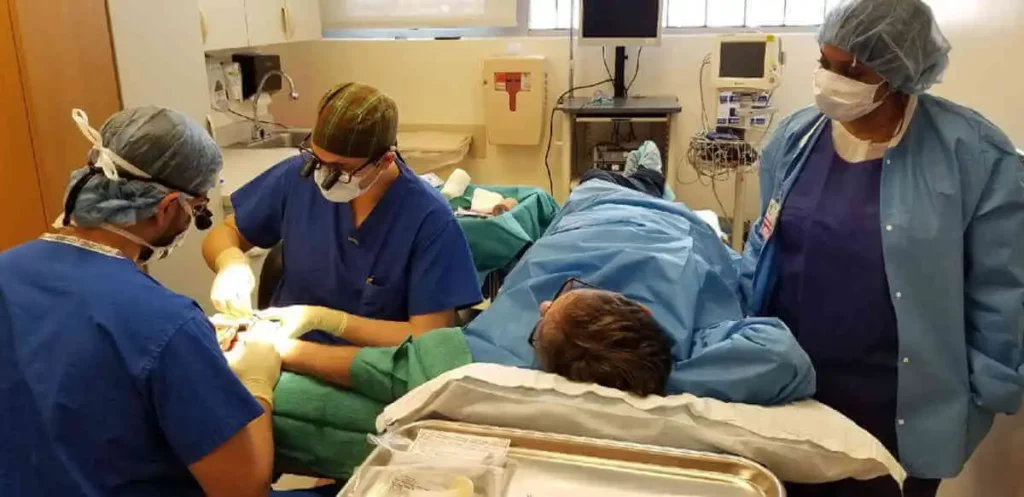Wide Awake Local Anaesthetic No Tourniquet (WALANT) surgery offers an alternative to traditional surgical methods by allowing you to remain fully awake while avoiding the need for general anaesthesia or a tourniquet. WALANT provides precise pain control, minimal bleeding, and an interactive surgical experience that can improve outcomes.
What is WALANT?
WALANT surgery uses a combination of local anaesthetic and adrenaline to numb the surgical area while minimising blood flow. This is achieved through precise injection techniques, ensuring the procedure is pain-free and well-tolerated. You remain awake throughout the surgery but will not feel any sharp or uncomfortable sensations. The injection uses a very fine needle to minimise any pain when the local anaesthetic is applied under the skin.
Unlike traditional methods that require a tourniquet to control bleeding, WALANT uses adrenaline to constrict blood vessels, eliminating the need for this device which can be uncomfortable and increase pain after surgery.

What operations can be performed using WALANT?
WALANT is suitable for various hand and wrist surgeries, including but not limited to:
- Carpal Tunnel Release: Pressure relief for the median nerve to reduce pain and improve hand function.
- Trigger Finger Release: Resolves the locking or catching of fingers due to tendon issues.
- Dupuytren’s Surgery: Removal of scar tissue causing fingers to permanently bend toward the palm.
This technique is particularly beneficial as you:
- Are able to avoid general anaesthesia or sedation which can cause nausea and a longer recovery from surgery
- Put less stress on your heart or lungs, especially important if you have any underlying health concerns
- Experience a quicker recovery from surgery and return to daily routines
- Are able to talk to your surgeon during the procedure, who will discuss some of the expectations and instructions for after surgery during wound closure
Advantages of WALANT surgery
WALANT surgery offers several unique benefits, including:
- Minimised risks:
- No general anaesthesia or sedative drugs, reducing potential side effects or interactions
- Particularly ideal for elderly or medically complex patients
- Real-time feedback:
- Patients can actively move their hand or fingers during surgery, helping the surgeon refine results and ensure the condition has been adequately treated in real time
- Immediate feedback ensures that repaired structures meet functional expectations
- Faster recovery:
- Patients avoid the drowsiness or “hangover” effect of sedation
- Quicker discharge from the hospital allows for a seamless return to daily life
- Improved motivation for recovery:
- Seeing the hand in action during surgery can be a powerful motivator during post-operative therapy
What are the downsides
Although issues are rare, they can include:
- Incomplete pain block with local anaesthetic, requiring a further injection to improve numbness
- Fear of seeing blood or surgical wounds – however you do not need to see any part of the operation and a large drape will separate you from the procedure, obscuring it from view
- You have to talk to the theatre team, and listen to us talk to you!
- Using too much local anaesthetic – however the maximum dose allowed is calculated based on your body weight and is not exceeded.
- There is a risk of blood supply issues to the area if you have pre-existing blood vessel problems such as Raynaud’s Disease or Vascular Disease – please make Dr Lambers aware if this is the case
What to expect during WALANT surgery
- Before Surgery: Dr Lambers will inject a local anaesthetic mixed with adrenaline into the surgical area to provide targeted numbness and minimise bleeding. This uses a very fine needle.
- During Surgery: You will remain awake and comfortable. You may be asked to move your fingers or hand as the surgeon assesses functionality in real time. Looking at the surgery is sometimes possible but during most of the procedure you won’t be able to see the surgery due to the blanket barriers in place for sterility.
- After Surgery: You can leave the hospital shortly after the procedure and resume light activities as recommended.
Is WALANT right for you?
WALANT surgery is an excellent option for individuals seeking a low-risk, effective, and efficient approach to hand and wrist procedures. However, discussing your unique medical history and preferences with Dr Lambers is important to ensure this technique aligns with your needs. WALANT is the standard treatment for most hand and many wrist conditions and general anaesthetic is rarely required.
Taking the time to explore your options and understand the benefits of WALANT will help you make a confident, informed decision about your care.

